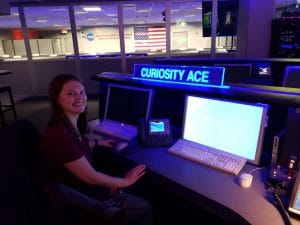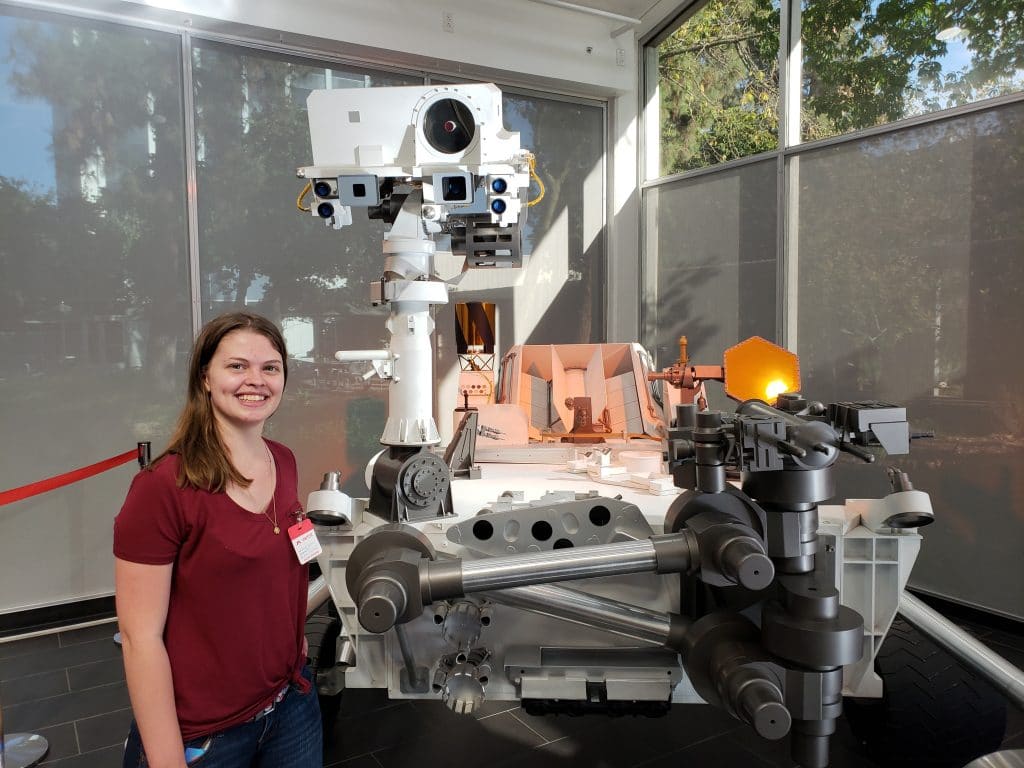Nov. 8, 2018
Nuclear-powered laser beams; Martian rocks vaporized to dust; clouds of plasma emitting light waves captured by space robots—to most, this sounds like the makings of a science-fiction novel. To Northern Arizona University doctoral student Sarah Lamm, this is just another day at work. As a member of NASA’s Curiosity mission team and a student of astronomy and planetary science, searching for signs of life on Mars is simply a science reality.
Curiosity is a car-sized rover designed by NASA to explore the surface of Mars; NAU has a lab that allows students and professors to direct the rover around the Red Planet. Lamm’s involvement is with the rover’s ChemCam: an infrared laser and camera that acts as the head and eye of Curiosity. Basically, the laser shoots rocks, vaporizing them into plasma that gives off light collected by spectrometers on Curiosity. The light gives off different wavelengths that correspond to different elements, and scientists back on Earth compare them with samples of known elemental concentrations. The process allows the team to approximate the chemical composition of rocks on Mars.
Lamm, who is part of assistant professor Mark Salvatore’s research team, does her tasks for the NASA team from labs at NAU, downloading data from the previous sol (equivalent of a Mars day), making initial reports from looking at pictures of the targeted rocks shot with lasers and analyzing the chemical composition. She makes note of anything interesting or unexpected and helps scientists decide what and where to shoot next.
“Sarah’s work is part of the broader mission goals of the Mars Science Laboratory Curiosity rover project,” Salvatore said. “We’re looking to better understand how the modern and ancient martian environments have left their imprint on the rocks that we find at and near the surface. Fortunately, we have competent geoscientists, like Sarah, working with really great data from the rover to help figure all of this out!”
Breaking down the main goal of Curiosity, Lamm said the team works to determine whether life could have existed on Mars by researching if the necessary conditions were present for life to have survived for a period of time. This is done with the help of the Curiosity rover, which uses geology, biology, chemistry and physics techniques to answer the big question. The team studies a number of elements on Mars, such as possible signs of water, weather and atmospheric conditions and the chemical compositions of rocks and soil.
Lamm’s involvement with Curiosity began in 2016 with a summer internship at the Los Alamos National Laboratory on the ChemCam instrument team. She returned for the next two summers, which is how she met Salvatore, an assistant professor in physics and astronomy with NAU and participating scientist on the Curiosity mission.

Salvatore, while visiting Los Alamos, recruited Lamm to consider NAU for her continued education. Though the university hadn’t been on Lamm’s shortlist, once she began investigating the opportunities NAU offered, she found it was a perfect match.
“I was looking for a graduate adviser who was also working on Curiosity so I could remain on the team. I also wanted a department where I could enter right into a Ph.D. program instead of getting a master’s,” Lamm said. “Flagstaff is a nice place to live, and the physics and astronomy department at NAU has world-class scientists who are helpful, relaxed and nice. NAU and Flagstaff fit all my criteria I was wanting in a graduate program.”
Since coming to NAU, Lamm’s efforts have been concentrated on projects involving Curiosity, looking for signs of chemical alterations of rocks on Mars. Lamm recently contributed a blog post to NASA’s website regarding the Curiosity rover mission and has more scheduled (her initial blog post was in August). The blogs, and Lamm, have been mentioned in news sources such as the technology and science focused website Gizmodo and the technology and electronic focused CNET.
The renewed interest came as Curiosity resumed operations following a memory anomaly it experienced in September. The rover was unable to transmit some of its stored data back to Earth but was still able to send real-time data that engineers used to diagnose the problem. While the anomaly still is under investigation, the Curiosity team switched to using the rover’s spare computer, allowing them to continue operations. Lamm’s ChemCam work wasn’t disrupted too much; Curiosity collects so much data that scientists like Lamm are typically analyzing earlier parts of the mission as new data continues to come in.
Although the Curiosity landed on Mars in 2012, Lamm explains the significance of keeping the public updated and interested in the space mission through things like blog posts so that the detailed work the Curiosity team does can continue.
“If the public knows what is going on with the rover, they will ask better questions and support space missions,” she said. “Public support is so important for space missions. We need to keep the energy high years after the initial excitement of landing on Mars. It is also a great way to show younger students how fun and exciting science is.”
Cheyenne Jarrette | NAU Communications
(928) 523-2282 | NAUComm@nau.edu




